It’s not overstating the case to say I was both shocked and amazed when I looked at these photos on my screen. What I saw was so very unexpected!
Deer have absolutely no choice but to jump fences and more often than not they’re successful. But the danger is that they often get hung up on them and meet an agonizing death. Such a fate awaits thousands of them every year on all types of fences but barbed wire is particularly dangerous to them.
I won’t present it here but if you want evidence of that fact do a Google Image Search using “deer caught on fence” as your search terms. But if you go there prepare yourself for a grisly ride.
Yesterday I photographed this Mule Deer (below) as it jumped a fence in Box Elder County and I was amazed by what I saw when I reviewed those photos on my screen when I arrived home. Despite the fact that they’re of fairly poor quality (some are soft and I was too close to the deer to photograph the behavior well) I believe they’re plenty good enough to document the unexpected behavior I witnessed.
All five images are presented in the order they were taken and there are no skips.
In this first shot most of the deer’s body has cleared the top strand of barbed wire but given its forward momentum it appears that the hind legs/feet may not clear it. If that were to happen the legs would likely slide down on the wire and catch the strand of wire below which would wrap those legs between the two wires and doom the deer.
That’s exactly what happens all too often in these situations.
So the deer used a creative method to get those hind legs over the wire. In midair it stepped on the second wire…
and used it as a “springboard” to…
clear the top wire (notice the “twang” of the second wire as it rebounds upward despite how tightly it was stretched on the fence).
I include this last image to show how far the deer had to drop before its front feet reached the ground. And keep in mind the speed of the jump – this sequence of 5 images took exactly 1/2 second to photograph.
Ungulates, including deer, are incredibly cognizant of exactly where their feet are (and where those feet are going next) even when running over broken ground at top speed so I believe the deer stepped on the wire deliberately – it was no fortunate accident. But if that very small hoof had missed its mark by even a half-inch or so the deer would likely have become just another sad statistic on the wire.
I’ve photographed deer and elk jumping barbed wire fences quite a few times and I’ve never seen anything like this. It makes me wonder if this is a jumping technique learned and used by only one or a few individuals or if all of them have it in their repertoire to use when needed.
I can’t help but marvel at the athletic prowess I witnessed but I shudder to think of what could have happened. I’m so very glad I didn’t have to use the wire cutters I always keep in my pickup now (since my two experiences with cutting owls out of barbed wire fences) to cut the wire and free the deer.
That would have been unpleasant for both of us…
Ron


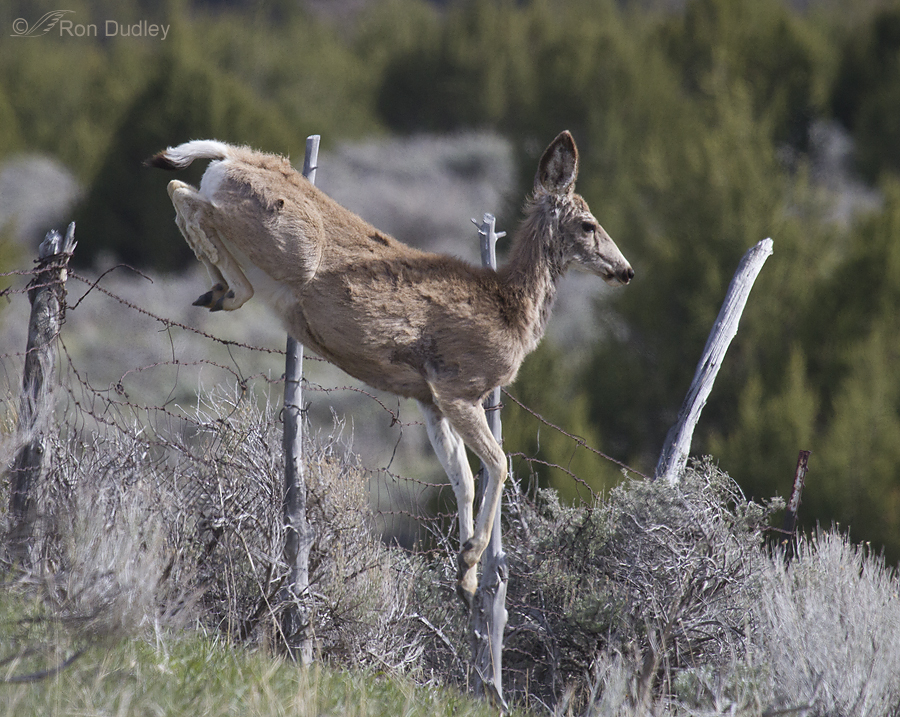
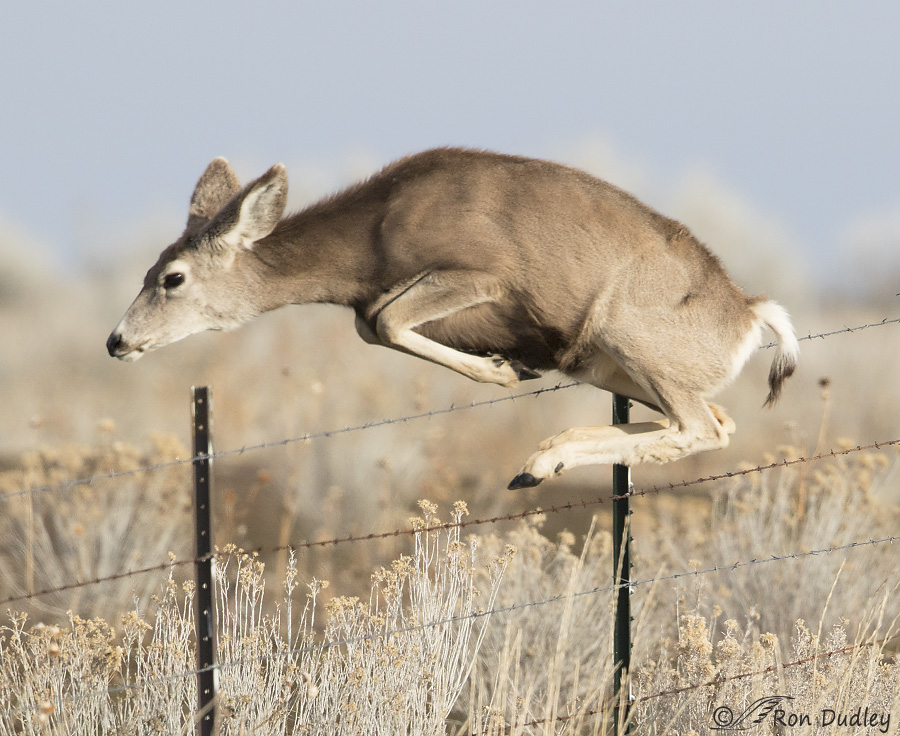
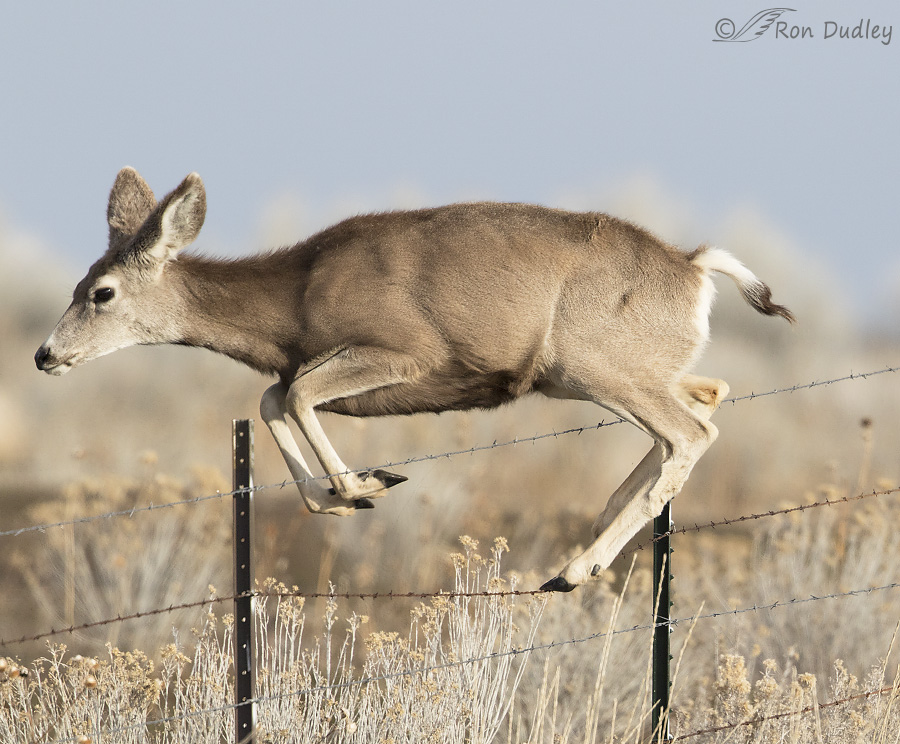
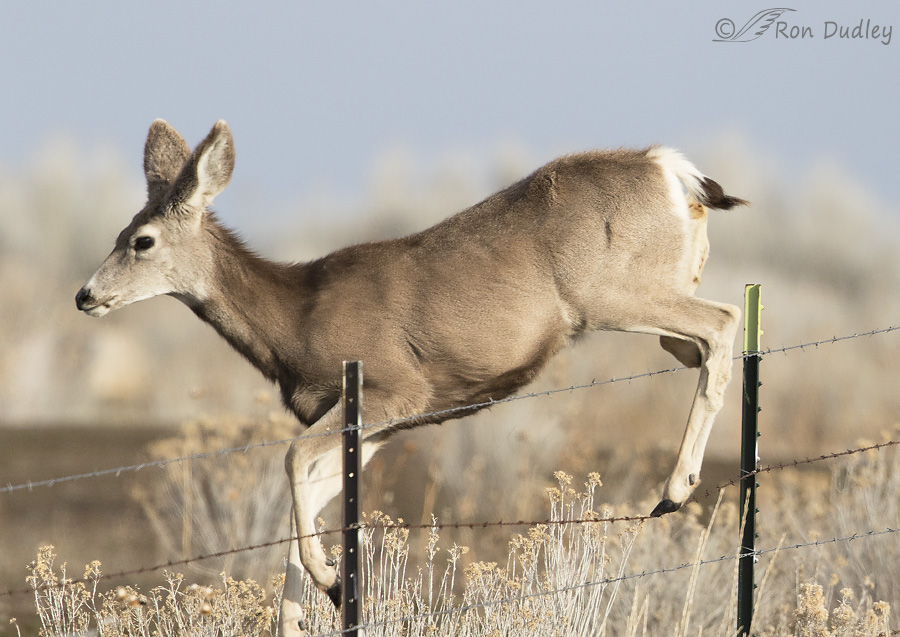
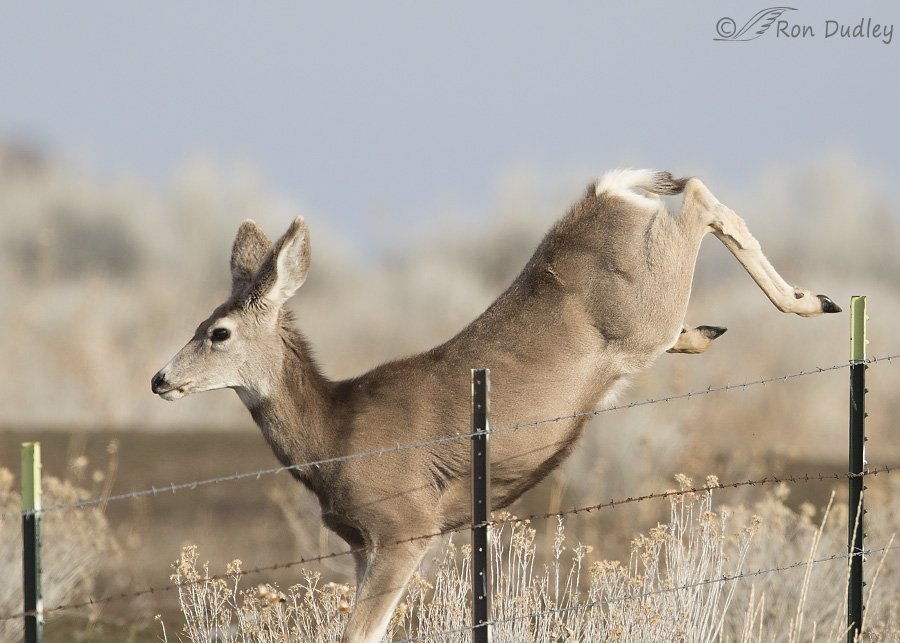
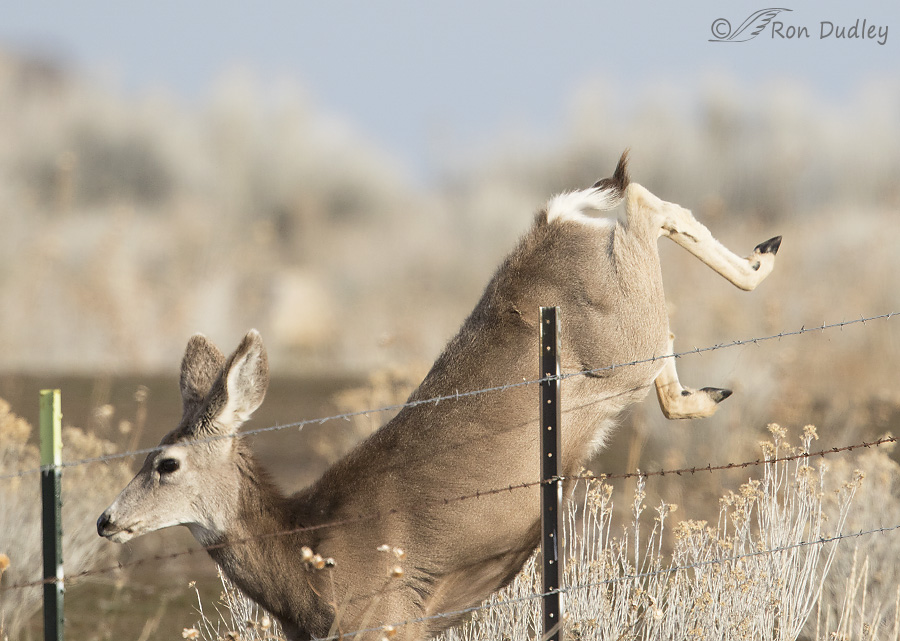
Love birds – however what a nice change. I was holding my breath while watching! Amazing it used the barbwire to its advantage!! I love this series and to think it was half a second! I’m sure there’s money to be made with these impossible actions!
Ha, maybe I can make enough to pay for the gas just to get up there, Linda! Thank you.
Clever, clever, clever.
And no, I didn’t go to the link.
My mind filled in the pain, the torment and the ugliness quite well without it.
EC, there’d be no reason for many of us to go to look at those photos. We already know the destructiveness of those fences. But some need the proof…
Really interesting series. I don’t even want to think about the alternative.
Nor do I…
I have seen the unfortunate results of deer not making it completely over a barb wire fence. I guess I am not terribly surprised they use their rear legs to help them get over a difficult fence, although I have never see one do it. But I am absolutely shocked that they are not using the top wire! You are absolutely right that this is a recipe for disaster. Great photos!
Ken
Thanks, Ken.
Ron, these are amazing photos. We have many [9 at a time] visit our backyard but I’ve never seen one jump. I wonder how high this fence was. Thanks so much for the photos.
Thanks, Alice. The top wire was probably no higher than about 5′.
Ron,
You never cease to amaze me.
Stephen
Thanks, Stephen. This one amazed me too.
Fantastic behavioural shot, especially that hind foot using the mid wire to push off. I once had a ,not quite as dramatic, but somewhat similar experience where I photographed an Ibex jumping a fence. Instead of jumping over at the lower wire, it jumped over at the 6 +/- inch (150 mm)diameter fence post, landing on and standing on top of it with all four feet for milli-second before jumping down.
That must have been a sight to see, Hank.
I hope it’s a learned behavior that will spread. What an amazing thing to have captured
Thank you, Arwen.
Glad and relieved that muley made it over thatceffing crap…
THANK YOU, ED…for asking the questions you asked…and for making at least some people think…I callthat cruel, evil, effing stuff “Devil Wire” or “Devil’s Wire” and I HATE it!!!! I almost didn’t open today’s blog but held my breath, trusted Ron and did. No, prongs don’t jump these effing fences, but they do huddle against them, freeze and starve to death each winter….horses, deer and sometimes, birds, suffer a different fate. I’d like to see some ranchers(esp. those who string that damned stuff on public lands) stripped naked, wrapped in devil’s wire and rolled slowly down a very loooong hill….
Patty, I think you know that if there had been any disturbing images here involving critters and barbed wire I’d have warned you when I sent you the link.
Yes…Thank you…
I am amazed by this behavior, too. In this case it was a smart solution, and I’m glad it worked. I wonder if the deer miscalculated when it started the jump? All sorts of animals are good at coming up with creative solutions to problems, and clearly this deer is no exception.
Susan, It makes me wonder if the deer had this planned prior to the jump or if it was a split-second decision in the middle of the jump.
Thanks Ron for your suggestions… I’ve considered the points that you mention myself,
and think my problem may arise from other causes… Do you use BBF? Thanks again.
Yes, I always use back-button focus.
WOW! I also have never seen a deer using the wire as a spring board for a jump! 1st deer looks to be in poor shape or is having a REALLY bad shed day. I’ve never seen an antelope jump a fence – they crawl through as the white tails often also do making them hell on fences at times. Barbed wire is a controversy. On one hand leaning cows/bulls need to be discouraged from that, on the other, the barbs are an issue for other critters the results of which we’ve witnessed more than once – more often with fawns than adults.
I’ve never seen an antelope jump a fence – they crawl through as the white tails often also do making them hell on fences at times. Barbed wire is a controversy. On one hand leaning cows/bulls need to be discouraged from that, on the other, the barbs are an issue for other critters the results of which we’ve witnessed more than once – more often with fawns than adults.
Judy, that first deer was just shedding. It looked like most of the others in the small herd it was with.
Ron, this is another amazing series, and your observations, and comments are very informative…
As a lover of the notion of trying to catch critters in motion, some months ago I set up three of
my Nikons, and my Canon 7D Mark II used with the 100-400 IS II, to use Back Button Focus.
Arthur Morris has pushed using that method for years, so I thought, why not try it? However,
I’m having limited success. There are times when I will will get a string of images totally out
of focus even though the focus spot was on the critter. Very frustrating to say the least!!!
Is there anything that you might suggest to help me figure out what I’m doing wrong? Do I
have the bodies “set up wrong,” or is it just dumb “operator error” that is to blame??? … Any
comments on your part will be greatly appreciated… Thanks Ron. ;-)))
Roger, When that happens to me (it happens to everyone at least occasionally) I sometimes wonder if I wasn’t depressing the focus button hard enough to keep AF active during the sequence. Sorry, I have no magic answers…
I have to say that I’m no fan of Arthur Morris (for a variety of reasons) but that’s irrelevant to your question…
Fascinating! great stop-motion illustration of such a delicate maneuver. I also, am always amazed at how white-tailed deer jump fences here too. And sometimes without much take off or landing space!
This jump was made from a standing start – the deer wasn’t running or even walking prior to the jump.
Amazing agility you have captured here Ron. I would not have imagined this was sheer luck, or a random moment. In other words the deer must have had some previous practice at this. Well done capturing more behavior.
Barbed wire…one of those “hand’s off cultural symbols of the American west”. I know that fences are needed, however I have seen enough damage to the native wildlife from barbed wire now that the same series of questions seems to come up for me:
1) Do we really need 4 or 5 strands?
2) Why can’t the lower strands be strung with barbless wire (I am seeing this in places, especially where Pronghorn roam).
3) What alternatives are there?
4) What is the cost / benefit of these fences on public (BLM) lands? Who actually pays the bill for installation and maintenance.
5) Wildlife climb-overs or climb-arounds seem to help with elk. What about for other wildlife?
6) How much do we really need the barbs?
Yes, I know some fencing is needed; that it is expensive and time consuming; I am not against fencing.
I am sure you have similar concerns and questions about barbed wire.
Thanks for listening to me rant
Yes, I have many of the same concerns and questions about barbed wire, Ed. But getting folks to change their ways is never easy and there is considerable expense involved in altering existing fences. But it could be done gradually over time to mitigate those costs.
One bit of info that I forgot to include. Curious if you or your blog audience has to say about this.
I have never seen Pronghorn jump a barbed wire fence. I have watched thousands of them, over many different incidences, and different situations, crawl under the lowest fence strand. When I asked some USG wildlife experts about this they informed me that Pronghorn do not jump fences.
I think it is true that Pronghorn do not jump fences. That is odd to me given their amazing speed and agility.
An important consideration of fencers is the height of the lower strands of the fence. It needs to be high enough to allow the Pronghorn to crawl underneath. The recommendation for Pronghorn friendly fences is for a three-strand fence, the bottom strand smooth wire (no barbs) with a height of 20 inches above the ground. A Landowner’s Guide to Friendly Fences
The impact on the pronghorn from poorly designed fences is significant. When a herd comes to a barbed wire fence with the lowest wire set too close to the ground, they’re forced to go along the fence — often for a mile or more — until they find a place where they can squeeze under it. The barbed wire tears their hair, exposing them to the cold. And those extra miles spent searching for a crossing add up over the course of a long migration. More miles equals more energy expended, and less time for eating. On the northern prairies, that loss of valuable calories can be the difference between survival and starvation. From Innovative fence to protect North America’s Pronghorn.
I have been on rural dirt roads and come across large herds of Pronghorn. My presence, or that of my truck, scares them and confuses them. In these cases I have sometimes seen them run back and forth looking for a safe crawl under of the fences. Thankfully it seems that most ranchers who know what they are doing keep the bottom strand as smooth wire and high enough off the ground…
Interesting that you bring this up, Ed. I’ve had (almost) the same experience as you with pronghorn not jumping fences. I’ve seen hundreds of them go under fences but I’d never seen even one jump a fence – until about three years ago in the Centennial Valley of Montana.
A doe pronghorn was trapped between two fences on either side of a gravel road as I approached in my pickup. I stopped on the road so I didn’t cause her to make a panicked decision that she (and I) would regret. After several attempts to go under the fence she ACTUALLY JUMPED OVER IT! I was so amazed I got out of my pickup and measured the height of the top wire that she jumped. If I remember correctly (and I think I do) it was just under 5′.
I haven’t seen a pronghorn jump a fence since that day but I’ve seen many, many more go under them.
Thanks Ron. That is some good data!
I guess what puzzles me about the Pronghorn is that they seem capable of jumping over 10 foot high fences, so why have they adapted their behavior to crawl under fences, instead of jumping over them? I would love to see some research on this, so I will look around.
Watching them scramble around trying to go under the fences makes me want to yell out at them… “Jump over it!”
In frustration I’ve actually hollered out to them out my pickup window – “Just jump the damned thing!”
WOW! I’ve seen White-tailed Deer seemingly effortlessly jump a barbed wire fence, but these pictures are amazing. I would have never guessed that they would use a strand of the fence wire as a spring board.
Great shots Ron, wonderful tell-tale ½ second series. I’ll pass on looking at the grisly images.
Many thanks for sharing!
Thanks, Dick. I don’t blame you for passing on those images. Some of them are truly heart-wrenching.